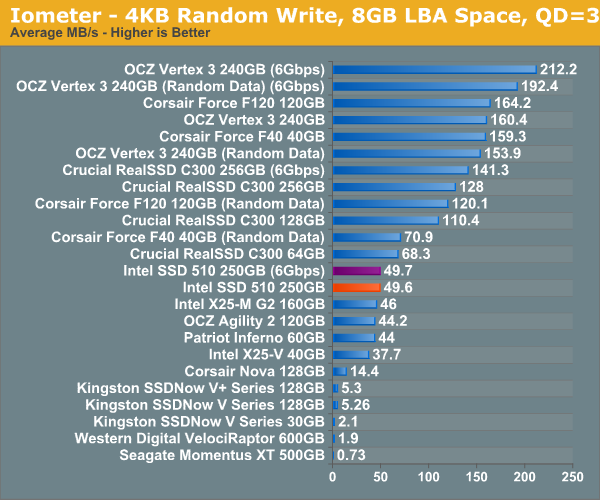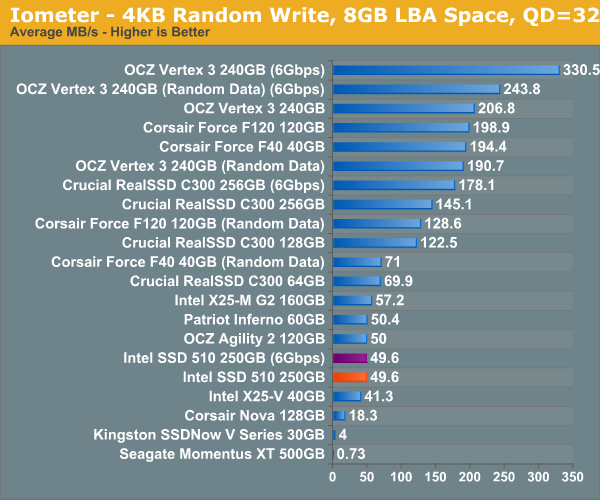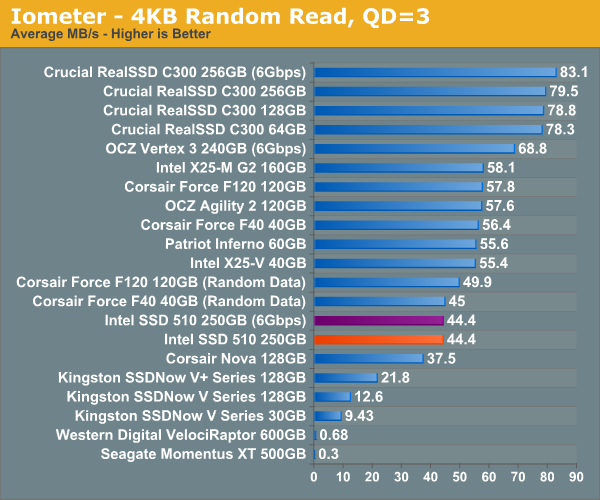The Intel SSD 510 Review
by Anand Lal Shimpi on March 2, 2011 1:23 AM EST- Posted in
- IT Computing
- Storage
- SSDs
- Intel
- Intel SSD 510
Random Read/Write Speed
The four corners of SSD performance are as follows: random read, random write, sequential read and sequential write speed. Random accesses are generally small in size, while sequential accesses tend to be larger and thus we have the four Iometer tests we use in all of our reviews.
Our first test writes 4KB in a completely random pattern over an 8GB space of the drive to simulate the sort of random access that you'd see on an OS drive (even this is more stressful than a normal desktop user would see). I perform three concurrent IOs and run the test for 3 minutes. The results reported are in average MB/s over the entire time. We use both standard pseudo randomly generated data for each write as well as fully random data to show you both the maximum and minimum performance offered by SandForce based drives in these tests. The average performance of SF drives will likely be somewhere in between the two values for each drive you see in the graphs. For an understanding of why this matters, read our original SandForce article.

It's a bit unfortunate for Intel that we happen to start our performance analysis with a 4KB random write test in Iometer. The 510's random write performance is only marginally better than the X25-M G2 at 49.7MB/s. The RealSSD C300 is faster, not to mention the SF-1200 based Corsair Force F120 and the SF-2200 based OCZ Vertex 3.
Although not depicted here, max write latency is significantly reduced compared to the X25-M G2. While the G2 would occasionally hit a ~900ms write operation, the 510 keeps the worst case latency to below 400ms. The Vertex 3 by comparison has a max write latency of anywhere from 60ms - 350ms depending on the type of data being written.
Many of you have asked for random write performance at higher queue depths. What I have below is our 4KB random write test performed at a queue depth of 32 instead of 3. While the vast majority of desktop usage models experience queue depths of 0 - 5, higher depths are possible in heavy I/O (and multi-user) workloads:

While the X25-M G2 scaled with queue depth in our random write test, the 510 does not. It looks like 50MB/s is the absolute highest performance we'll see for constrained 4KB random writes. Note that these numbers are for 4KB aligned transfers, performance actually drops down to ~40MB/s if you perform sector aligned transfers (e.g. performance under Windows XP).

Random read performance is just as disappointing. The X25-M G2 took random read performance seriously but the 510 is less than 20% faster than the Indilinx based Corsair Nova. When I said the Intel SSD 510's random performance is decidedly last-generation, I meant it.










128 Comments
View All Comments
TrackSmart - Wednesday, March 2, 2011 - link
It would be silly to return the Vertex 2 (my opinion). Just check out the PCMark Vantage scores in this article. There's little real world difference between all of the high end drives. Without the benchmarks, there's no way to tell the drives apart.But if it's going to eat you up inside, knowing you were just a 2-3 months away from having the latest model, go ahead. I'll be keeping be enjoying my OCZ Agility 2 in the mean time.
JohnBooty - Wednesday, March 2, 2011 - link
"I'm wondering if I should return the [Vertex 2] and just wait for the Vertex 3"I've got a mix of Vertex 1's, Intel G1s, Intel G2, and Vertex 2's in a variety of machines at home and at work.
For workstation usage as a software dev, there's not a heck of a lot of subjective (ie, "it feels faster") difference between them. At this level of disk performance, your machine just isn't waiting on the hard drive very often.
Obviously you may have specific needs. I used to work for a client who had a 8GB database that I was constantly backing up and restoring many times a day in the course of development work. Now there was a situation where raw read/write speeds were king and the Vertex 3 probably would have performed close to 2x faster. For me that kind of usage is the exception and not the rule though.
sean.crees - Wednesday, March 2, 2011 - link
I didn't see any discussion on internal garbage collection (ie: NOT trim).Does it have any?
In my mind, this will be the key deciding feature between Intel and Vertex 3. Whichever has the better garbage collection without TRIM. Remember, TRIM still doesn't work in a RAID array or in OSX.
MrCromulent - Wednesday, March 2, 2011 - link
+1. I'm really eager for an IGC comparison of the Intel 510, the Vertex 3 and if possible, also of a current firmware version of the Crucial C300 (since the drive still competes very well).In Anand's initial test, the C300 suffered from very poor IGC, but Marvell supposedly alleviated this problem in their new firmware releases. Unfortunately, no IGC tests have been conducted with the 0006 firmware yet.
halcyon - Wednesday, March 2, 2011 - link
Hate to do this, but+1.
It's not what's the latest, but what's offers the best bang for buck after upgrades.
Such a review would be immensely helpful.
Although based on the Intel 510 TRIM-test random write results, it may have to wait for the first Intel FW upgrade as the numbers with the shipping FW are truly appalling.
Syan48306 - Saturday, March 5, 2011 - link
I'm dying to know how it will hold up in my macbook pro. I finally caved and bought one of these 510 SSD's and although it's after the fact, I still want to know how long it'll still be "good" in my system.tim851 - Wednesday, March 2, 2011 - link
If the original X25-M "conroe'd" the market, it seems G3 "atomed" it. In the way that Intel, in their crusade to maximize profits and segmentize the market, designed quite a bit to conservatively.I'm all for it though, because I believe that currently, the last thing SSDs are lacking is speed, so the last thing they really need is more of it. I believe at this point just about everybody would want one, if it weren't for the prohibitively high prices. So if Intel can half the per-GB-price of the G3, I'll buy one for sure!
anactoraaron - Wednesday, March 2, 2011 - link
+1I thought the exact same thing about the 1st gen drive compared to this one. What makes SSD's "feel" so much faster is the random read/write performance. When the 40GB X25-V is so close to matching random read/write the 510 will just "feel" slow, especially once you have everything installed on it. I mean, really, who cares about sequential performance once you have everything on the drive that you planned putting on it?
Anand, please put the current WD velociraptor numbers into this graph. It will demonstrate what I mean.
Glad I didn't wait and got my 60GB Vertex 2...
anactoraaron - Wednesday, March 2, 2011 - link
oh yeah if I just looked I would see the velociraptor numbers... lol its late and I should be asleep... maybe I am? Did Intel just atom their next SSD?Golgatha - Wednesday, March 2, 2011 - link
I think this is a fair criticism. I also only look at the random R/W performance of these new SSDs. I can pull 215 MB/s R/W from my 300GB Velociraptors in RAID0, and use these drives to install all my games on since game loading performance is largely determined by sequential reading of data from the disks (lots of big sequential files), and because I need around 400GB of space currently for all my game installs .Sequential reads for most SSDs are lower than the 215 MB/s reads I enjoy from my Velociraptors in RAID0. I have a Crucial C300 256MB in this same desktop and I also use an 80GB Intel G2 in my laptop; both of these drives are slower than my Velociraptors in RAID0 in terms of sequential read performance. Also, there is obviously a space concern, in that there isn't enough space on either of these drives to install my games to them.
Now for the host OS and all the random programs I run in parallel, a SSD gives you huge gains and the system just feels snappier. This is largely due to random R/W performance. Basically you'd be hard pressed to tell the difference between sequentially reading 10MB of data or less at 215MB/s (Velociraptors in RAID0) vs 320MB/s (my Crucial C300 256MB average speed on a PCIe4x, SATA3, ASUS add-in card), hence the reason that sequential performance of SSDs doesn't matter much to me anymore.
Now if I could get a 512GB or bigger SSD with greater than 215MB/s sequential read performance for less than $1/GB, I might bite on that. So far this product has not come to market, so I'll stick with my Velociraptors until it does.